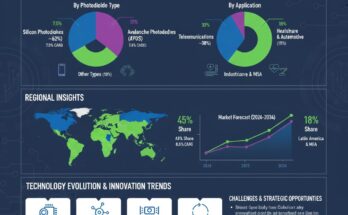As per industry analysis by Fact.MR – a market research and competitive intelligence provider, the market for LiDAR sensor market is expected to grow at a CAGR of 12.7% over the period of forecast.
Autonomous vehicles, as well as connected cars, are predicted to increase the demand for LiDAR sensors as they help the vehicles identify obstacles on their path. Innovations in vehicle automation and transportation planning will play a key role in transforming the automotive industry throughout the forecast period.
The integration of LiDAR sensors in the field of meteorology has made it its biggest contributor to the market share of the end use of LiDAR sensors. They help us understand the weather conditions by providing the meteorological department insights into the data that it has collected.
Read Detailed Report: Click Here
Key Takeaways from LiDAR Sensor Market Study
- The global LiDAR sensor market is projected to expand at an impressive CAGR of 7% and be valued at US$ 6,328.7 Mn by 2032.
- The market witnessed a 3% CAGR for the period of 2017-2021.
- Under technology type, Solid State LiDAR Sensor dominates the market and is estimated to be valued at US$ 1,414.9 million in 2022.
- East Asia dominated the market with an 9% market share in 2022.
- Vehicle Automation applications are likely to represent 9% market share in 2022.
- Based on region, demand for LiDAR Sensor is expected to increase at a CAGR of 3% and 10.9% in Europe and MEA respectively during the forecasted period.
Current Trends in The LiDAR(Light Detection & Ranging) Sensor
- The global LiDAR market 2019 was valued at USD 960 Million in 2019. This market is anticipated to cross a valuation of USD 5.35 Billion by 2030.
- The automotive industry is a major contributor to China and Japan’s economy. In Japan automotive sector is greatly consolidated with suppliers and small and medium enterprises. The domestic dominance of companies in Japan notifies them remains at the core of the whole industry.
- Japan has a favorable projection for the light detection and ranging market intended to improve fully autonomous driving. Manufacturers are investing in 3D LiDAR sensors to provide essential information for object detection and depth resolution. Companies like Jenoptik invest in custom LiDAR creation for challenging tasks such as automotive, industrial, mobility, and security markets.
- Smartphones are recently being integrated with LiDAR to cover various applications. In 2020, iPad Pro and iPhone 12 Pro have become the first phones to integrate LiDAR scanners to scan and model outdoor and indoor environments.
- A LiDAR integrated Mobile platform to produce accurate geospatial 3D point cloud. Where large georeferenced information is captured and carried in an efficient and fast way. This can be used in multivariate applications such as planning urban spaces and restructuring cultural heritage.
- United states anticipated holding 37% of the global LiDAR arcade share by 2030 this expects more competition in North American manufacturers in the forecast duration.
- Semiconductors are a significant part of modern electronics which make up commonly used in smartphones, PCs, and Tablets. These devices gaining prominence in daily life are anticipated to make the semiconductor industry expensive and highly competitive in the coming days. The global semiconductor market sales in 2021 crossed USD 595 Billion. This drives demand for LiDAR sensors across the consumer electronics sector globally.
Market Development
The global LiDAR sensor market is highly competitive. LiDAR technology has found its applications in the augmented reality industry as well. It provides detailed 3D mapping that enables other systems to integrate this information with their data. The LiDAR technology helps increase augmented reality’s experience.
LiDAR is being used by scientists to understand the atmosphere on a deeper level. These sensors provide scientists with information about the vegetation cycles. When scientists receive data that show that there is destruction in vegetation, new policies are used to save it.
In the field of engineering and construction, LiDAR sensors are being used to create detailed spatial maps before designing the real structure, this helps them reduce errors and as a result, saves them a lot of money

